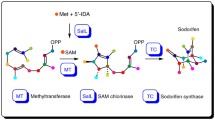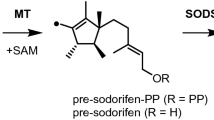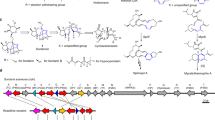Abstract
Prodiginines, which are tripyrrole alkaloids displaying a wide array of bioactivities, occur as linear and cyclic congeners. Identification of an unclustered biosynthetic gene led to the discovery of the enzyme responsible for catalyzing the regiospecific C–H activation and cyclization of prodigiosin to cycloprodigiosin in Pseudoalteromonas rubra. This enzyme is related to alkylglycerol monooxygenase and unrelated to RedG, the Rieske oxygenase that produces cyclized prodiginines in Streptomyces, implying convergent evolution.
This is a preview of subscription content, access via your institution
Access options
Access Nature and 54 other Nature Portfolio journals
Get Nature+, our best-value online-access subscription
$29.99 / 30 days
cancel any time
Subscribe to this journal
Receive 12 print issues and online access
$259.00 per year
only $21.58 per issue
Buy this article
- Purchase on Springer Link
- Instant access to full article PDF
Prices may be subject to local taxes which are calculated during checkout


Similar content being viewed by others
References
Papireddy, K. et al. J. Med. Chem. 54, 5296–5306 (2011).
Stankovic, N., Senerovic, L., Ilic-Tomic, T., Vasiljevic, B. & Nikodinovic-Runic, J. Appl. Microbiol. Biotechnol. 98, 3841–3858 (2014).
Williamson, N.R. et al. Future Microbiol. 2, 605–618 (2007).
Montaner, B. & Pérez-Tomás, R. Life Sci. 68, 2025–2036 (2001).
Yamamoto, C. et al. Hepatology 30, 894–902 (1999).
Jones, B.T., Hu, D.X., Savoie, B.M. & Thomson, R.J. J. Nat. Prod. 76, 1937–1945 (2013).
Lee, J.S. et al. Appl. Environ. Microbiol. 77, 4967–4973 (2011).
Sydor, P.K. et al. Nat. Chem. 3, 388–392 (2011).
Salem, S.M. et al. J. Am. Chem. Soc. 136, 4565–4574 (2014).
Withall, D.M., Haynes, S.W. & Challis, G.L. J. Am. Chem. Soc. 137, 7889–7897 (2015).
Kimata, S., Izawa, M., Kawasaki, T. & Hayakawa, Y. J Antibiot. (Tokyo) 70, 196–199 (2017).
Kancharla, P., Lu, W., Salem, S.M., Kelly, J.X. & Reynolds, K.A. J. Org. Chem. 79, 11674–11689 (2014).
Hu, D.X., Withall, D.M., Challis, G.L. & Thomson, R.J. Chem. Rev. 116, 7818–7853 (2016).
Williamson, N.R., Fineran, P.C., Leeper, F.J. & Salmond, G.P.C. Nat. Rev. Microbiol. 4, 887–899 (2006).
Xie, B.-B. et al. J. Bacteriol. 194, 1637–1638 (2012).
Williamson, N.R. et al. Mol. Microbiol. 56, 971–989 (2005).
Shanklin, J., Guy, J.E., Mishra, G. & Lindqvist, Y. J. Biol. Chem. 284, 18559–18563 (2009).
Bai, Y. et al. Nature 524, 252–256 (2015).
Tang, M.-C., Zou, Y., Watanabe, K., Walsh, C.T. & Tang, Y. Chem. Rev. 117, 5226–5333 (2017).
Watschinger, K. & Werner, E.R. IUBMB Life 65, 366–372 (2013).
Watschinger, K. et al. Biochem. J. 443, 279–286 (2012).
Futai, M. J. Membr. Biol. 15, 15–28 (1974).
Mayer, M. et al. Pteridines 24, 105–109 (2013).
Chawrai, S.R., Williamson, N.R., Mahendiran, T., Salmond, G.P.C. & Leeper, F.J. Chem. Sci. 3, 447–454 (2012).
Barry, S.M. & Challis, G.L. ACS Catal. 3, 2362–2370 (2013).
Johnson, R.E., de Rond, T., Lindsay, V.N.G., Keasling, J.D. & Sarpong, R. Org. Lett. 17, 3474–3477 (2015).
Dairi, K., Tripathy, S., Attardo, G. & Lavallée, J.-F. Tetrahedr. Lett. 47, 2605–2606 (2006).
Hillson, N.J., Rosengarten, R.D. & Keasling, J.D. ACS Synth. Biol. 1, 14–21 (2012).
Wang, P. et al. Microb. Cell Fact. 14, 11 (2015).
Alihosseini, F., Lango, J., Ju, K.-S., Hammock, B.D. & Sun, G. Biotechnol. Prog. 26, 352–360 (2010).
Batth, T.S., Keasling, J.D. & Petzold, C.J. Methods Mol. Biol. 944, 237–249 (2012).
Finn, R.D. et al. Nucleic Acids Res. 42, D222–D230 (2014).
Price, M.N., Dehal, P.S. & Arkin, A.P. Mol. Biol. Evol. 26, 1641–1650 (2009).
UniProt Consortium. Nucleic Acids Res. 43, D204–D212 (2015).
Letunic, I. & Bork, P. Nucleic Acids Res. 44, W242–W245 (2016).
Acknowledgements
We thank A. Deutschbauer for gifting E. coli WM3064. We thank I. Budin, J. Alonso-Gutierrez, M. Thompson, D. Fercher, J. Barajas, C. Eiben, C. Bailey, S. Richardson, M. Brown, M. Garber, S. Nies, C. Meadows, T.S. Lee, L. Katz, and S. Weschler for helpful discussions; E. de Ugarte for work on the graphical abstract; as well as S. Gardner, E. Coyne, and M. Agnitsch for everyday support. This work was supported by ERASynBio (81861: “SynPath”) to J.D.K., the NIGMS (086374) to R.S., and the UC Berkeley SURF Rose Hills fellowship to P.S., as well as the DOE Joint BioEnergy Institute and the DOE Joint Genome Institute, both funded by the US Department of Energy, Office of Science, Office of Biological and Environmental Research, through contract DE-AC02-05CH11231 between Lawrence Berkeley National Laboratory and the US Department of Energy. The publisher, by accepting the article for publication, acknowledges that the United States Government retains a nonexclusive, paid-up, irrevocable, worldwide license to publish or reproduce the published form of this manuscript, or allow others to do so, for United States Government purposes.
Author information
Authors and Affiliations
Contributions
T.d.R., R.E.J., R.S., and J.D.K. conceived of the study. T.d.R., P.S. and I.E. constructed plasmids and performed microbiological manipulations and extractions, R.E.J. performed synthetic organic chemistry. T.d.R., E.E.K.B., and C.J.P. performed analytical chemistry, L.J.G.C. and C.J.P. performed proteomic analysis, and G.G. and N.J.H. PCR amplified and purified DNA fragments. T.d.R. performed bioinformatic analysis. All authors contributed to the manuscript.
Corresponding authors
Ethics declarations
Competing interests
The authors declare no competing financial interests.
Supplementary information
Supplementary Text and Figures
Supplementary Results, Supplementary Tables 1–7, Supplementary Figures 1–14. (PDF 6404 kb)
Rights and permissions
About this article
Cite this article
de Rond, T., Stow, P., Eigl, I. et al. Oxidative cyclization of prodigiosin by an alkylglycerol monooxygenase-like enzyme. Nat Chem Biol 13, 1155–1157 (2017). https://doi.org/10.1038/nchembio.2471
Received:
Accepted:
Published:
Issue Date:
DOI: https://doi.org/10.1038/nchembio.2471
This article is cited by
-
Correlational networking guides the discovery of unclustered lanthipeptide protease-encoding genes
Nature Communications (2022)
-
Structures, biosynthesis, and bioactivities of prodiginine natural products
Applied Microbiology and Biotechnology (2022)
-
A comprehensive review on recent trends in production, purification, and applications of prodigiosin
Biomass Conversion and Biorefinery (2022)
-
Co-occurrence of enzyme domains guides the discovery of an oxazolone synthetase
Nature Chemical Biology (2021)
-
C–H activation
Nature Reviews Methods Primers (2021)



